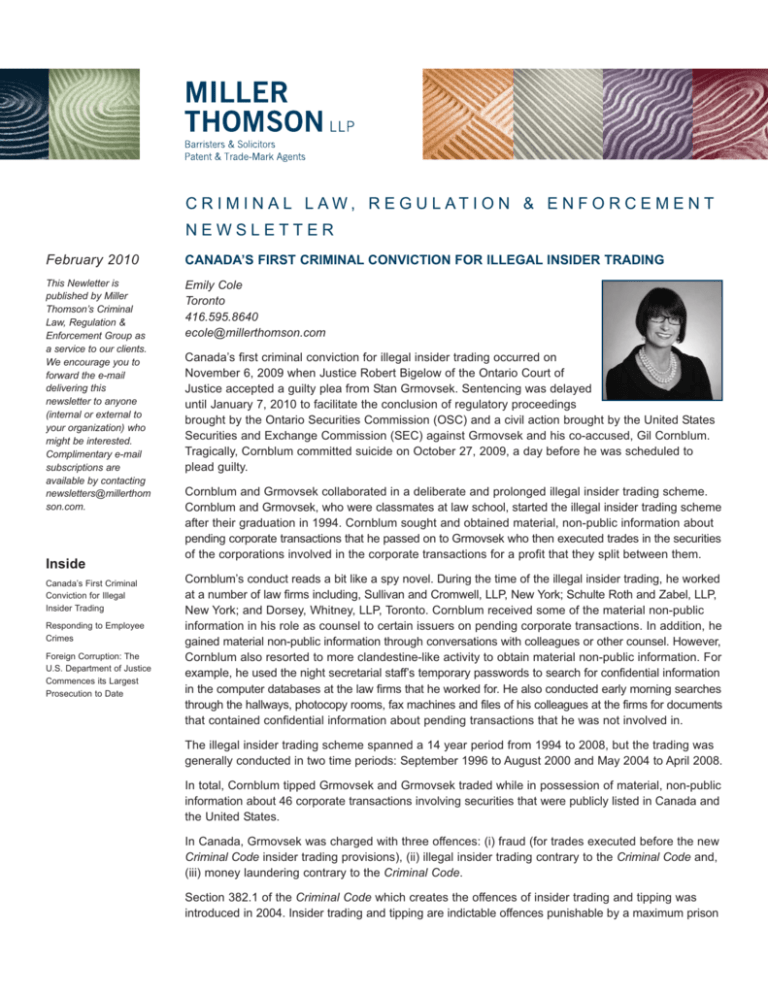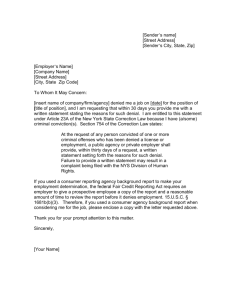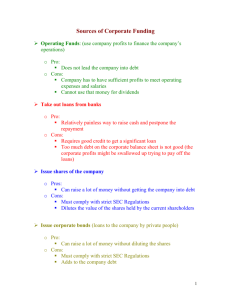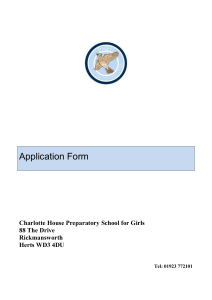
C R I M I N A L L AW, R E G U L AT I O N & E N F O R C E M E N T
NEWSLETTER
February 2010
CANADA’S FIRST CRIMINAL CONVICTION FOR ILLEGAL INSIDER TRADING
This Newletter is
published by Miller
Thomson’s Criminal
Law, Regulation &
Enforcement Group as
a service to our clients.
We encourage you to
forward the e-mail
delivering this
newsletter to anyone
(internal or external to
your organization) who
might be interested.
Complimentary e-mail
subscriptions are
available by contacting
newsletters@millerthom
son.com.
Emily Cole
Toronto
416.595.8640
ecole@millerthomson.com
Inside
Canada’s First Criminal
Conviction for Illegal
Insider Trading
Responding to Employee
Crimes
Foreign Corruption: The
U.S. Department of Justice
Commences its Largest
Prosecution to Date
Canada’s first criminal conviction for illegal insider trading occurred on
November 6, 2009 when Justice Robert Bigelow of the Ontario Court of
Justice accepted a guilty plea from Stan Grmovsek. Sentencing was delayed
until January 7, 2010 to facilitate the conclusion of regulatory proceedings
brought by the Ontario Securities Commission (OSC) and a civil action brought by the United States
Securities and Exchange Commission (SEC) against Grmovsek and his co-accused, Gil Cornblum.
Tragically, Cornblum committed suicide on October 27, 2009, a day before he was scheduled to
plead guilty.
Cornblum and Grmovsek collaborated in a deliberate and prolonged illegal insider trading scheme.
Cornblum and Grmovsek, who were classmates at law school, started the illegal insider trading scheme
after their graduation in 1994. Cornblum sought and obtained material, non-public information about
pending corporate transactions that he passed on to Grmovsek who then executed trades in the securities
of the corporations involved in the corporate transactions for a profit that they split between them.
Cornblum’s conduct reads a bit like a spy novel. During the time of the illegal insider trading, he worked
at a number of law firms including, Sullivan and Cromwell, LLP, New York; Schulte Roth and Zabel, LLP,
New York; and Dorsey, Whitney, LLP, Toronto. Cornblum received some of the material non-public
information in his role as counsel to certain issuers on pending corporate transactions. In addition, he
gained material non-public information through conversations with colleagues or other counsel. However,
Cornblum also resorted to more clandestine-like activity to obtain material non-public information. For
example, he used the night secretarial staff’s temporary passwords to search for confidential information
in the computer databases at the law firms that he worked for. He also conducted early morning searches
through the hallways, photocopy rooms, fax machines and files of his colleagues at the firms for documents
that contained confidential information about pending transactions that he was not involved in.
The illegal insider trading scheme spanned a 14 year period from 1994 to 2008, but the trading was
generally conducted in two time periods: September 1996 to August 2000 and May 2004 to April 2008.
In total, Cornblum tipped Grmovsek and Grmovsek traded while in possession of material, non-public
information about 46 corporate transactions involving securities that were publicly listed in Canada and
the United States.
In Canada, Grmovsek was charged with three offences: (i) fraud (for trades executed before the new
Criminal Code insider trading provisions), (ii) illegal insider trading contrary to the Criminal Code and,
(iii) money laundering contrary to the Criminal Code.
Section 382.1 of the Criminal Code which creates the offences of insider trading and tipping was
introduced in 2004. Insider trading and tipping are indictable offences punishable by a maximum prison
term of 10 years. The distinction between the Criminal Code offence of prohibited insider trading and the
Ontario Securities Act offence of illegal insider trading is that the criminal offence imports a mens rea
requirement that the individual “knowingly used inside information,” whereas in the regulatory context the
Crown is only required to prove that the individual was in possession of knowledge that was not generally
disclosed.
On January 7, 2010, Bigelow J. sentenced Grmovsek to 39 months imprisonment on the joint recommendation
of the prosecution and the defence.
In the United States, the SEC alleged that Grmovsek violated the anti-fraud provisions, including prohibitions
against insider trading. On January 13, 2010, Grmovsek pleaded guilty and was convicted of one count of
conspiracy to defraud the United States in the United States District Court for the Southern District of New
York. He was sentenced to a term of imprisonment of time served and fined one hundred dollars.
In addition to the jail terms, Grmovsek agreed to disgorgement orders to the United States Securities and
Exchange Commission (SEC) at a total of $8.5 million dollars with a waiver of all but nearly $1.5 million and
to the Ontario Securities Commission (OSC) at a total of $1.03 million dollars, including $283,000.00 to the
Attorney General for Ontario. Grmovsek also agreed to pay $250,000.00 in costs relating to the OSC investigation.
Grmovsek traded in the US and the Canadian capital markets and the disgorgement orders reflect the
proportion of profits made in each of the United States and Canada.
Justice Bigelow described the sentence against Grmovsek as “entirely appropriate and justified.” Bigelow J.
also noted that “it has a strong denunciatory and general deterrent effect.”
The Grmovsek jail sentence exceeds the longest sentence to date in an illegal insider trading prosecution
brought by the OSC under section 122 of the Ontario Securities Act. In 2000, Glen Harvey received a
sentence of six months jail on conviction of two counts of insider trading. At that time, the maximum sentence
under the Securities Act was two years imprisonment and/or a basic fine of $1 million dollars or in insider
trading offences up to three times the profit. Harper profited $4 million dollars as a result of his illegal insider
trading and the fine of $2 million dollars represented half of his profits. The current penalties available under
section 122 of the Securities Act are five years imprisonment and/or a $5 million fine.
The OSC’s settlement agreement with Grmovsek stated that Cornblum and Grmovsek provided extensive
cooperation in assisting all regulatory authorities and law enforcement agencies involved in identifying the
depth and breadth of the conduct at issue. In particular, it stated that many of the corporate transactions that
occurred in the 1994 to 2000 period were identified by the two respondents from memory. It also noted that
staff’s investigation and analysis of those transactions was aided by Cornblum and Grmovsek’s testimony
as the records of some of the transactions particularly those with offshore components were incomplete.
Although the Commission has not yet released its reasons, Grmovsek’s cooperation was undoubtedly taken
into consideration in meting out the sentence.
Emily Cole recently joined Miller Thomson as Associate Counsel after several years as Senior Litigation
Counsel in the Enforcement Branch of the Ontario Securities Commission. She practices securities litigation
and regulation and white-collar defence. Ms Cole is admitted to practice in both Ontario and New York and
has extensive experience in cross-border investigations, defence and prosecution.
RESPONDING TO EMPLOYEE CRIMES
Adrienne Campbell
Toronto
416.595.2661
acampbell@millerthomson.com
On occasion, employers find themselves facing a situation where an employee is
suspected of having committed a criminal act such as fraud, theft, pornography, drunk
driving, or assault, that has the potential to impact on the workplace, or on the
employer’s reputation. These actions can occur either within, or outside, the workplace.
2
It is settled law in Canada that not every finding of misdoing on the part of an employee is grounds for
termination of employment for cause. The employer must first consider whether the wrongdoing in question
forms a fundamental breach of the employment relationship for which the only proper remedy is termination
of employment.
It may be tempting to handle the matter by simply terminating the employment relationship if and when the
police lay charges, and then relying on the decision of the police to lay those charges and any police investigation
as support for the decision to terminate. However, even where the police lay criminal charges after conducting
their own investigation, this alone will not be grounds to terminate the employment relationship for cause.
In the absence of a clear finding of guilt by the criminal court, for example where the charges are dropped
by the Crown, or the court finds find the former employee not guilty, the employer may have no defence to
a subsequent wrongful dismissal action. This is particularly the case where there has been no independent
investigation by the employer to support the decision to terminate the employment relationship. It is extremely
important that in most cases the employer conduct its own independent investigation before coming to a
conclusion on the appropriate disciplinary step to take.
Except in the most extreme cases, the decision to terminate employment for cause must be based on the
employer’s own investigation and assessment of the situation. This means that the employer or an investigator
retained by the employer must meet with the employee, get a full explanation from the employee of the
situation and response to any allegations, if necessary interview any witnesses, consider any extenuating
circumstance, and then reach a decision on whether or not there are grounds to terminate the employment.
There is no obligation under the Criminal Code on employers whose employees have stolen from them to
report all such matters to the police. It is often prudent to consider and balance a number of business
implications before deciding whether to report the matter. For example, will involving the police act as a
sufficient deterrent to other employees, particularly where the criminal act involves customers or other members
of the public? Will it be necessary to involve other employees and possibly customers as witnesses in any
subsequent criminal proceedings. How widely may the matter then be publicized? Even if the employer
does decide to contact the police, timing is important, as once criminal charges are laid, the employer will
likely find it difficult to directly interview the employee, whose lawyer will likely advise him or her not to
make any statements. This will seriously interfere in the employer’s ability to conduct its own investigation.
Not long ago the Ontario Court of Appeal considered whether an employer owed a duty of care to an employee
who was wrongly accused after a faulty investigation conducted by a third party retained by the employer.
In that case, a long time supervisor was fired, immediately handed over to the police and arrested for alleged
theft and drug dealing in the workplace, based on the findings of the undercover private investigator. However,
the wrong employee was fired and handed over to the police. The actual suspect had a similar name, but
was much younger than this employee. The Court declined to hold the employer liable for participating in
the negligent workplace investigation. However, the Court did note that, if the employer participated in a
negligent investigation knowing the serious consequences of a wrongful charge of criminal conduct against
the employee, there was still the possibility that such conduct could meet the requirement for a claim by the
wrongfully accused employee of intentional infliction of mental distress.
Once charges have been laid, an employer is faced with whether to allow the employee to continue to work
pending resolution of the charges. This will depend on the nature of the charges, and the impact they may
have on the workplace and/or the employer’s reputation. For example, where an employee who works in a
social services or child care setting is charged with possession of pornography or other sexual related crimes,
the employer has to consider its own liability of keeping the employee working pending a determination of guilt.
The employer has various options, including placing the employee on a paid or unpaid leave of absence,
terminating the employment relationship on a without cause basis by paying out the appropriate notice, or
terminating the employment for cause.
Adrienne Campbell is a member of our Labour and Employment Group in Toronto. In addition to providing
legal services and advice to a wide range of clients in the private and public sectors, she also has extensive
experience investigating complaints of inappropriate workplace conduct on behalf of employers and advising
them how to handle the outcome of such investigations.
3
F O R E I G N C O R R U P T I O N : T H E U . S . D E PA R T M E N T O F J U S T I C E
C O M M E N C E S I T S L A R G E S T P R O S E C U T I O N TO D AT E
J. Bruce McMeekin
Markham
905.415.6791
bmcmeekin@millerthomson.com
In January, twenty-two executives and employees from a number of American
companies were indicted for offences contrary to the U.S. Foreign Corrupt Practices
Act (the “FCPA”). The accused had allegedly conspired to pay bribes through an
agent to the Minister of Defence of an unnamed African state in return for the
Minister’s agreement to contract with the companies for the purchase of military and law enforcement equipment.
In reality, this was an “undercover” operation with the involvement of the Minister fabricated and the middleman
a disguised Federal Bureau of Investigations (FBI) agent.
What is interesting about the investigation is the huge commitment of law enforcement resources when the
intended bribes were relatively small – 20 per cent of contracts totalling $15 (U.S.) million. For the first time,
U.S. law enforcement employed sophisticated undercover techniques to detect and investigate the violations.
Over 120 FBI agents were on the case, executing fourteen search warrants. Another seven warrants were
executed by British police.
The FCPA is the U.S. legislative response to its treaty obligations under the OECD Convention on Combating
Bribery of Foreign Public Officials in International Business Transactions and the UN Convention Against
Corruption. Each breach of the FCPA is subject to a maximum prison sentence of 5 years. The Canadian
equivalent, the Corruption of Foreign Officials Act (“CFOA”) (described in our May 2008 newsletter) contains
comparable provisions prohibiting Canadian business organizations and their employees, agents and consultants,
from offering a benefit to a foreign public official if the purpose is to obtain or retain for the organization a
business advantage. These are serious offences, providing for 5-year maximum jail terms for individuals and
unlimited fines for both individuals and their employers.
Unlike the U.S., historically Canada has not committed large resources to the enforcement of the CFOA, although
two seven-officer RCMP teams were organized in 2008 to give the legislation some teeth. However, Canadian
executives would be mistaken to conclude that their Canadian residency may protect them from U.S. indictments
for violations of the FCPA. The Act is intended to apply to foreign employees and agents of U.S. publicly held
companies or companies headquartered in the U.S. Foreign nationals resident outside the U.S. have been
successfully prosecuted for FCPA violations.
The tenacity of U.S. law enforcement coupled with the likelihood of greater Canadian enforcement highlights
the CFOA and FCPA as areas of ongoing risk for companies operating abroad. Corporate leaders should
ensure they are knowledgeable about the legislative requirements and be satisfied that they have taken the
necessary steps to ensure employees involved in international transactions are properly trained and have ready
access to corporate resources to assist them in ensuring their involvement with foreign officials does not offend
anti-corruption legislation.
Bruce McMeekin is a partner in the Markham office and represents companies and individuals under
investigation and/or charged with regulatory and white collar criminal offences.
4
MILLER THOMSON
GROUP
LLP
Toronto/Markham
Douglas Best
dbest@millerthomson.com
C R I M I N A L L AW, R E G U L AT I O N A N D E N F O R C E M E N T
Note:
416.595.8588
Bryan J. Buttigieg
bbuttigieg@millerthomson.com
416.595.8172
Adrienne Campbell
acampbell@millerthomson.com
416.595.2661
David W. Chodikoff
dchodikoff@millerthomson.com
416.595.8626
Emily Cole
ecole@millerthomson.com
416.595.8640
Robert England
rengland@millerthomson.com
416.595.8566
Roderick M. McLeod, Q.C.
rmcleod@millerthomson.com
905.415.6707
J.Bruce McMeekin
bmcmeekin@millerthomson.com
905.415.6791
Andrew Roman
aroman@millerthomson.com
416.595.8604
Stuart Rudner
srudner@millerthomson.com
905.415.6767
Adam Stephens
astephens@millerthomson.com
416.595.8572
Katherine Xilinas
kxilinas@millerthomson.com
416.595.8165
Vancouver
Daniel L. Kiselbach
dkiselbach@millerthomson.com
Donald J. Sorochan, Q.C.
dsorochan@millerthomson.com
604.643.1263
604.643.1214
Calgary
Fred R. Fenwick, Q.C.
ffrenwick@millerthomson.com
403.298.2421
Edmonton
Daniel C.P. Stachnik, Q.C.
dstachnik@millerthomson.com
780.429.9761
This newsletter is provided as an information service to our
clients and is a summary of current legal issues. These articles
are not meant as legal opinions and readers are cautioned
not to act on information provided in this newsletter without
seeking specific legal advice with respect to their unique
circumstances. Miller Thomson LLP uses your contact
information to send you information on legal topics that may
be of interest to you. It does not share your personal
information outside the firm, except with subcontractors who
have agreed to abide by its privacy policy and other rules.
© Miller Thomson LLP, 2010 All Rights Reserved. All Intellectual
Property Rights including copyright in this publication are
owned by Miller Thomson LLP. This publication may be
reproduced and distributed in its entirety provided no
alterations are made to the form or content. Any other form
of reproduction or distribution requires the prior written
consent of Miller Thomson LLP which may be requested from
the editor at newsletters@millerthomson.com
w w w. m i l l e r t h o m s o n . c o m









